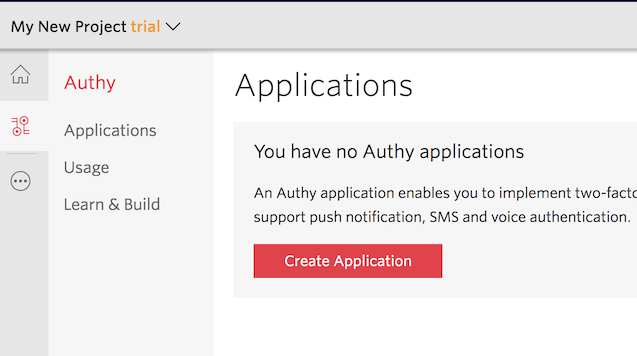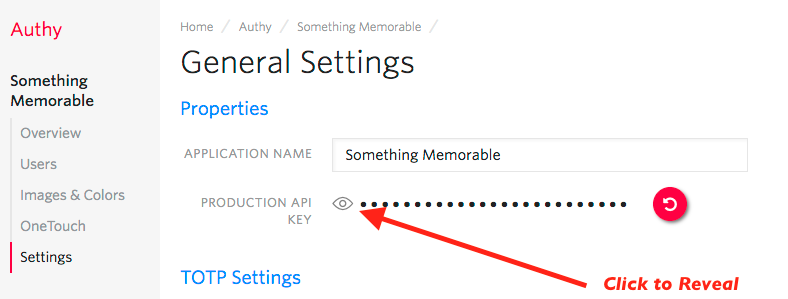.NET Core C# Two-factor Authentication Quickstart
Warning
As of November 2022, Twilio no longer provides support for Authy SMS/Voice-only customers. Customers who were also using Authy TOTP or Push prior to March 1, 2023 are still supported. The Authy API is now closed to new customers and will be fully deprecated in the future.
For new development, we encourage you to use the Verify v2 API.
Existing customers will not be impacted at this time until Authy API has reached End of Life. For more information about migration, see Migrating from Authy to Verify for SMS.
Adding two-factor authentication to your application is the easiest way to increase security and trust in your product without unnecessarily burdening your users. This quickstart guides you through building an ASP.NET Core, AngularJS, and SQL Server application that restricts access to a URL. Four Authy API channels are demoed: SMS, Voice, Soft Tokens and Push Notifications.
Ready to protect your toy app's users from nefarious balaclava wearing hackers? Dive in!
Create a new Twilio account (you can sign up for a free Twilio trial), or sign into an existing Twilio account.
Once logged in, visit the Authy Console. Click on the red 'Create New Aplication' (or big red plus ('+') if you already created one) to create a new Authy application then name it something memorable.

You'll automatically be transported to the Settings page next. Click the eyeball icon to reveal your Production API Key.

Copy your Production API Key to a safe place, you will use it during application setup.
This two-factor authentication demos two channels which require an installed Authy app to test: Soft tokens and push authentications. While SMS and voice channels will work without the client, to try out all four authentication channels download and install the Authy app for Desktop or Mobile:
Start by cloning our repository. Then, enter the directory and install dependencies:
_10git clone https://github.com/TwilioDevEd/account-security-csharp.git_10cd account-security-csharp/src/AccountSecurity_10dotnet restore
Next, open the file appsettings.json. There, edit the AuthyApiKey, pasting in the API Key from the above step (in the console), and save .
Enter the API Key from the Account Security console.
_12{_12 "Logging": {_12 "LogLevel": {_12 "Default": "Warning"_12 }_12 },_12 "AllowedHosts": "*",_12 "ConnectionStrings": {_12 "DefaultConnection": "Server=127.0.0.1;Database=account_security;Trusted_Connection=True;MultipleActiveResultSets=true;Integrated Security=False;User ID=sa;Password=yourStrong(!)Password"_12 },_12 "AuthyApiKey": "Your-Authy-Api-Key"_12}
When a user registers with your application, a request is made to Twilio to add that user to your App, and a user_id is returned. In this demo, we'll store the returned user_id in an MSSQL database.
On Windows, you can install the free SQL Server Express:
On Linux or Mac, run it as a docker container:
_10docker run -e 'ACCEPT_EULA=Y' -e 'SA_PASSWORD=yourStrong(!)Password' \_10_10-p 1433:1433 --name mssql -d microsoft/mssql-server-linux:latest
Warning
Make sure your DefaultConnection connection string in appsettings.json is correct for your SQL Server installation. You may need to change the Server to localhost\\SQLEXPRESS if running MSSQL Server Express on Windows. Or, you may need to change the password if you selected a different one when starting your Docker container.
Run the database migrations:
_10dotnet ef database update -v
Once you have added your API Key, you are ready to run! Run the app with:
_10dotnet run --environment development
With your phone (optionally with the Authy client installed) nearby, open a new browser tab and navigate to https://localhost:5001/register/
Enter your information and invent a password, then hit 'Register'. Your information is passed to Twilio (you will be able to see your user immediately in the console), and the application is returned a user_id.
Now visit https://localhost:5001/login/ and login. You'll be presented with a happy screen:

If your phone has the Authy app installed, you can immediately enter a soft token from the client to Verify. Additionally, you can try a push authentication simply by pushing the labeled button.
If you do not have the Authy app installed, the SMS and voice channels will also work in providing a token. To try different channels, you can logout to start the process again.
_203using System;_203using System.Collections.Generic;_203using System.Net;_203using System.Net.Http;_203using System.Threading.Tasks;_203using AccountSecurity.Models;_203using Microsoft.Extensions.Configuration;_203using Microsoft.Extensions.Logging;_203using Newtonsoft.Json;_203using Newtonsoft.Json.Linq;_203_203_203namespace AccountSecurity.Services_203{_203 public interface IAuthy_203 {_203 Task<string> registerUserAsync(RegisterViewModel user);_203 Task<TokenVerificationResult> verifyTokenAsync(string authyId, string token);_203 Task<TokenVerificationResult> verifyPhoneTokenAsync(string phoneNumber, string countryCode, string token);_203 Task<string> sendSmsAsync(string authyId);_203 Task<string> phoneVerificationCallRequestAsync(string countryCode, string phoneNumber);_203 Task<string> phoneVerificationRequestAsync(string countryCode, string phoneNumber);_203 Task<string> createApprovalRequestAsync(string authyId);_203 Task<object> checkRequestStatusAsync(string onetouch_uuid);_203 }_203_203 public class Authy : IAuthy_203 {_203 private readonly IConfiguration Configuration;_203 private readonly IHttpClientFactory ClientFactory;_203 private readonly ILogger<Authy> logger;_203 private readonly HttpClient client;_203_203 public string message { get; private set; }_203_203 public Authy(IConfiguration config, IHttpClientFactory clientFactory, ILoggerFactory loggerFactory)_203 {_203 Configuration = config;_203 logger = loggerFactory.CreateLogger<Authy>();_203_203 ClientFactory = clientFactory;_203 client = ClientFactory.CreateClient();_203 client.BaseAddress = new Uri("https://api.authy.com");_203 client.DefaultRequestHeaders.Add("Accept", "application/json");_203 client.DefaultRequestHeaders.Add("user-agent", "Twilio Account Security C# Sample");_203_203 // Get Authy API Key from Configuration_203 client.DefaultRequestHeaders.Add("X-Authy-API-Key", Configuration["AuthyApiKey"]);_203 }_203_203 public async Task<string> registerUserAsync(RegisterViewModel user)_203 {_203 var userRegData = new Dictionary<string, string>() {_203 { "email", user.Email },_203 { "country_code", user.CountryCode },_203 { "cellphone", user.PhoneNumber }_203 };_203 var userRegRequestData = new Dictionary<string, object>() { };_203 userRegRequestData.Add("user", userRegData);_203 var encodedContent = new FormUrlEncodedContent(userRegData);_203_203 var result = await client.PostAsJsonAsync("/protected/json/users/new", userRegRequestData);_203_203 logger.LogDebug(result.Content.ReadAsStringAsync().Result);_203_203 result.EnsureSuccessStatusCode();_203_203 var response = await result.Content.ReadAsAsync<Dictionary<string, object>>();_203_203 return JObject.FromObject(response["user"])["id"].ToString();_203 }_203_203 public async Task<TokenVerificationResult> verifyTokenAsync(string authyId, string token)_203 {_203 var result = await client.GetAsync($"/protected/json/verify/{token}/{authyId}");_203_203 logger.LogDebug(result.ToString());_203 logger.LogDebug(result.Content.ReadAsStringAsync().Result);_203_203 var message = await result.Content.ReadAsStringAsync();_203_203 if (result.StatusCode == HttpStatusCode.OK)_203 {_203 return new TokenVerificationResult(message);_203 }_203_203 return new TokenVerificationResult(message, false);_203 }_203_203 public async Task<TokenVerificationResult> verifyPhoneTokenAsync(string phoneNumber, string countryCode, string token)_203 {_203 var result = await client.GetAsync(_203 $"/protected/json/phones/verification/check?phone_number={phoneNumber}&country_code={countryCode}&verification_code={token}"_203 );_203_203 logger.LogDebug(result.ToString());_203 logger.LogDebug(result.Content.ReadAsStringAsync().Result);_203_203 var message = await result.Content.ReadAsStringAsync();_203_203 if (result.StatusCode == HttpStatusCode.OK)_203 {_203 return new TokenVerificationResult(message);_203 }_203_203 return new TokenVerificationResult(message, false);_203 }_203_203 public async Task<string> sendSmsAsync(string authyId)_203 {_203 var result = await client.GetAsync($"/protected/json/sms/{authyId}?force=true");_203_203 logger.LogDebug(result.ToString());_203_203 result.EnsureSuccessStatusCode();_203_203 return await result.Content.ReadAsStringAsync();_203 }_203_203 public async Task<string> phoneVerificationCallRequestAsync(string countryCode, string phoneNumber)_203 {_203 var result = await client.PostAsync(_203 $"/protected/json/phones/verification/start?via=call&country_code={countryCode}&phone_number={phoneNumber}",_203 null_203 );_203_203 var content = await result.Content.ReadAsStringAsync();_203_203 logger.LogDebug(result.ToString());_203 logger.LogDebug(content);_203_203 result.EnsureSuccessStatusCode();_203_203 return await result.Content.ReadAsStringAsync();_203 }_203_203 public async Task<string> phoneVerificationRequestAsync(string countryCode, string phoneNumber)_203 {_203 var result = await client.PostAsync(_203 $"/protected/json/phones/verification/start?via=sms&country_code={countryCode}&phone_number={phoneNumber}",_203 null_203 );_203_203 var content = await result.Content.ReadAsStringAsync();_203_203 logger.LogDebug(result.ToString());_203 logger.LogDebug(content);_203_203 result.EnsureSuccessStatusCode();_203_203 return await result.Content.ReadAsStringAsync();_203 }_203_203 public async Task<string> createApprovalRequestAsync(string authyId)_203 {_203 var requestData = new Dictionary<string, string>() {_203 { "message", "OneTouch Approval Request" },_203 { "details", "My Message Details" },_203 { "seconds_to_expire", "300" }_203 };_203_203 var result = await client.PostAsJsonAsync(_203 $"/onetouch/json/users/{authyId}/approval_requests",_203 requestData_203 );_203_203 logger.LogDebug(result.ToString());_203 var str_content = await result.Content.ReadAsStringAsync();_203 logger.LogDebug(str_content);_203_203 result.EnsureSuccessStatusCode();_203_203 var content = await result.Content.ReadAsAsync<Dictionary<string, object>>();_203 var approval_request_data = (JObject)content["approval_request"];_203_203 return (string)approval_request_data["uuid"];_203 }_203_203 public async Task<object> checkRequestStatusAsync(string onetouch_uuid)_203 {_203 var result = await client.GetAsync($"/onetouch/json/approval_requests/{onetouch_uuid}");_203 logger.LogDebug(result.ToString());_203 var str_content = await result.Content.ReadAsStringAsync();_203 logger.LogDebug(str_content);_203_203 result.EnsureSuccessStatusCode();_203_203 return await result.Content.ReadAsAsync<object>();_203 }_203 }_203_203 public class TokenVerificationResult_203 {_203 public TokenVerificationResult(string message, bool succeeded = true)_203 {_203 this.Message = message;_203 this.Succeeded = succeeded;_203 }_203_203 public bool Succeeded { get; set; }_203 public string Message { get; set; }_203 }_203}
And there you go, two-factor authentication is on and your .NET Core C# App is protected!
Now that you are keeping the hackers out of this demo app using two-factor authentication, you can find all of the detailed descriptions for options and API calls in our Authy API Reference. If you're also building a registration flow, also check out our Twilio Verify product and the Verification Quickstart which uses this codebase.
For additional guides and tutorials on account security and other products, in C# and in other languages, take a look at the Docs.